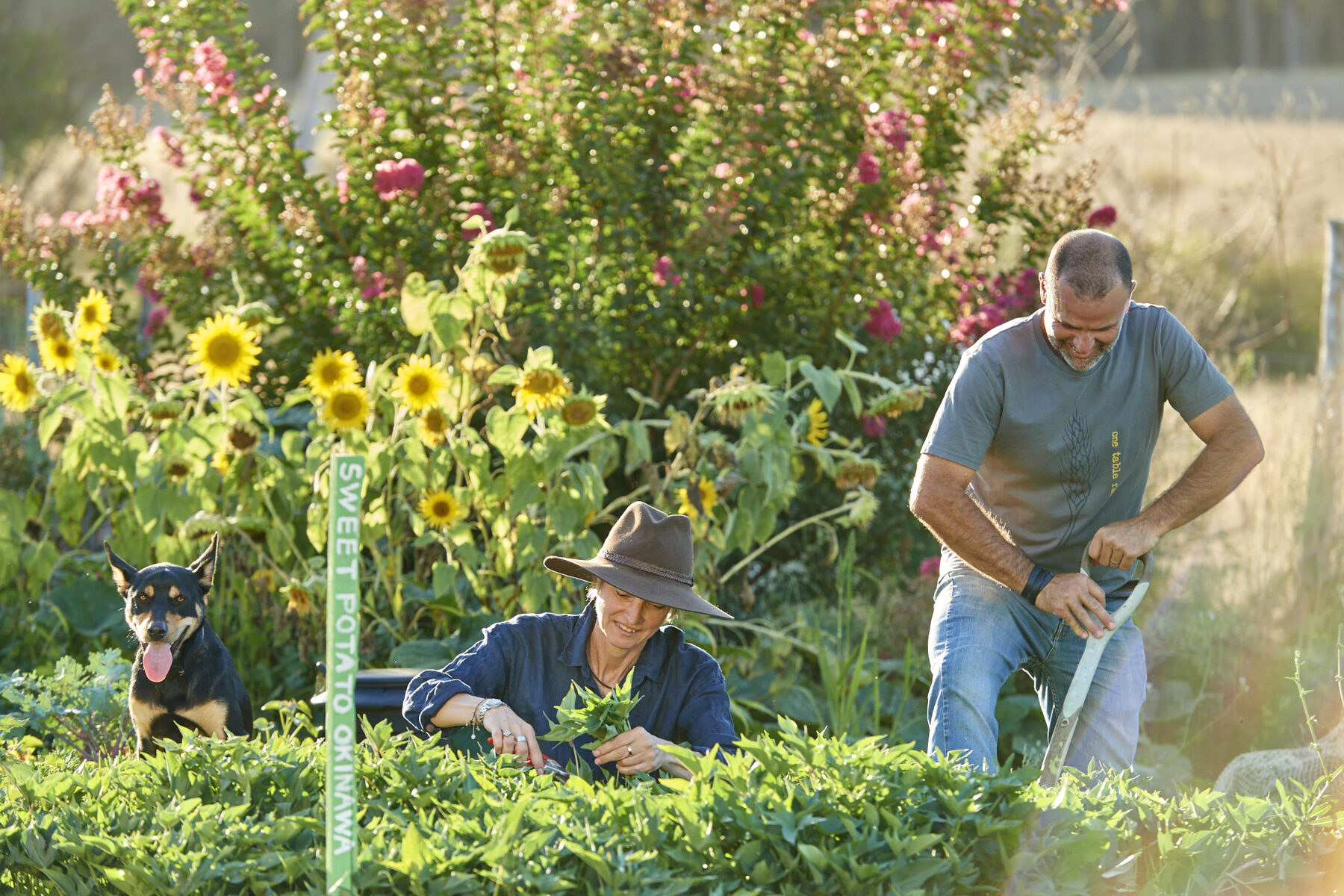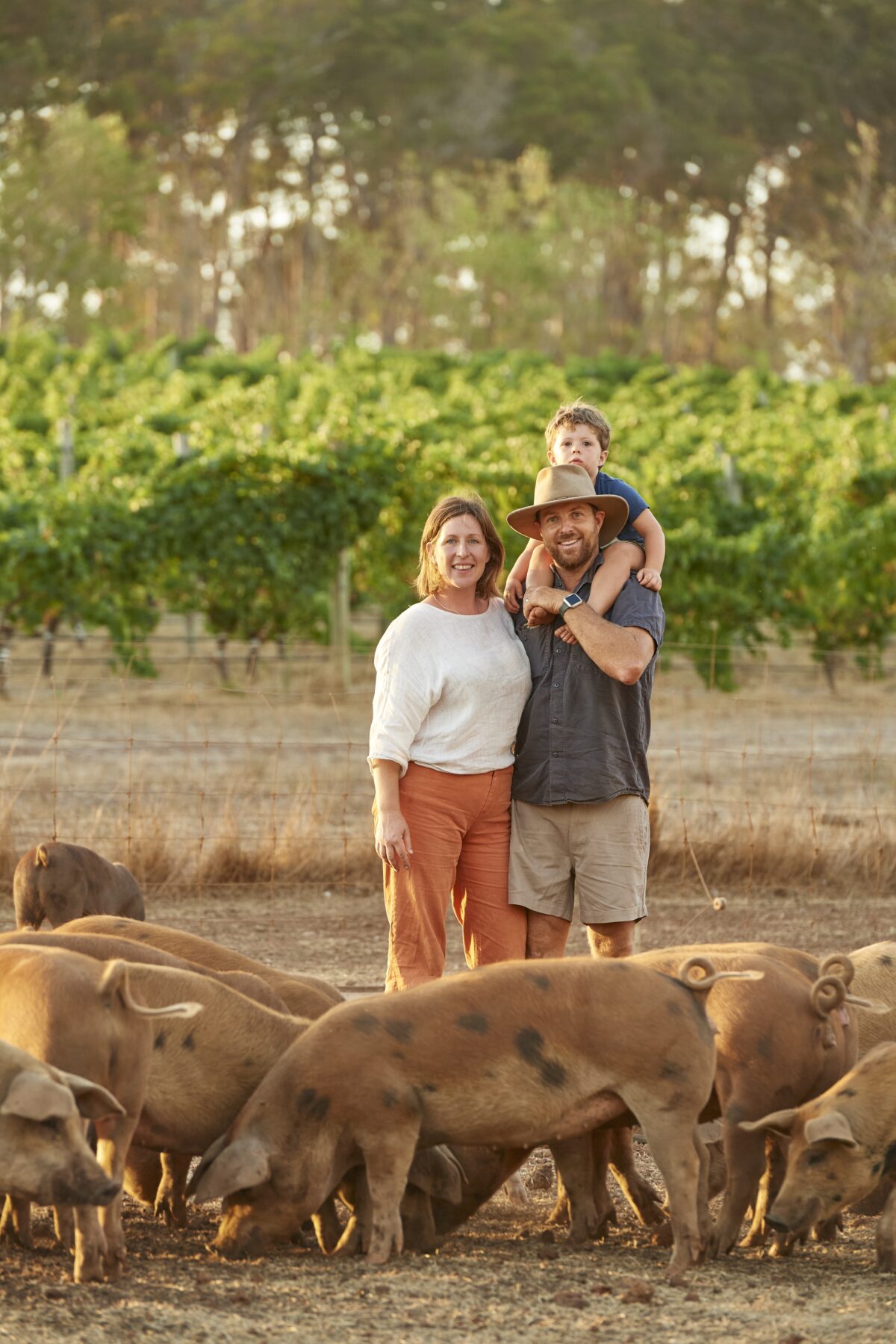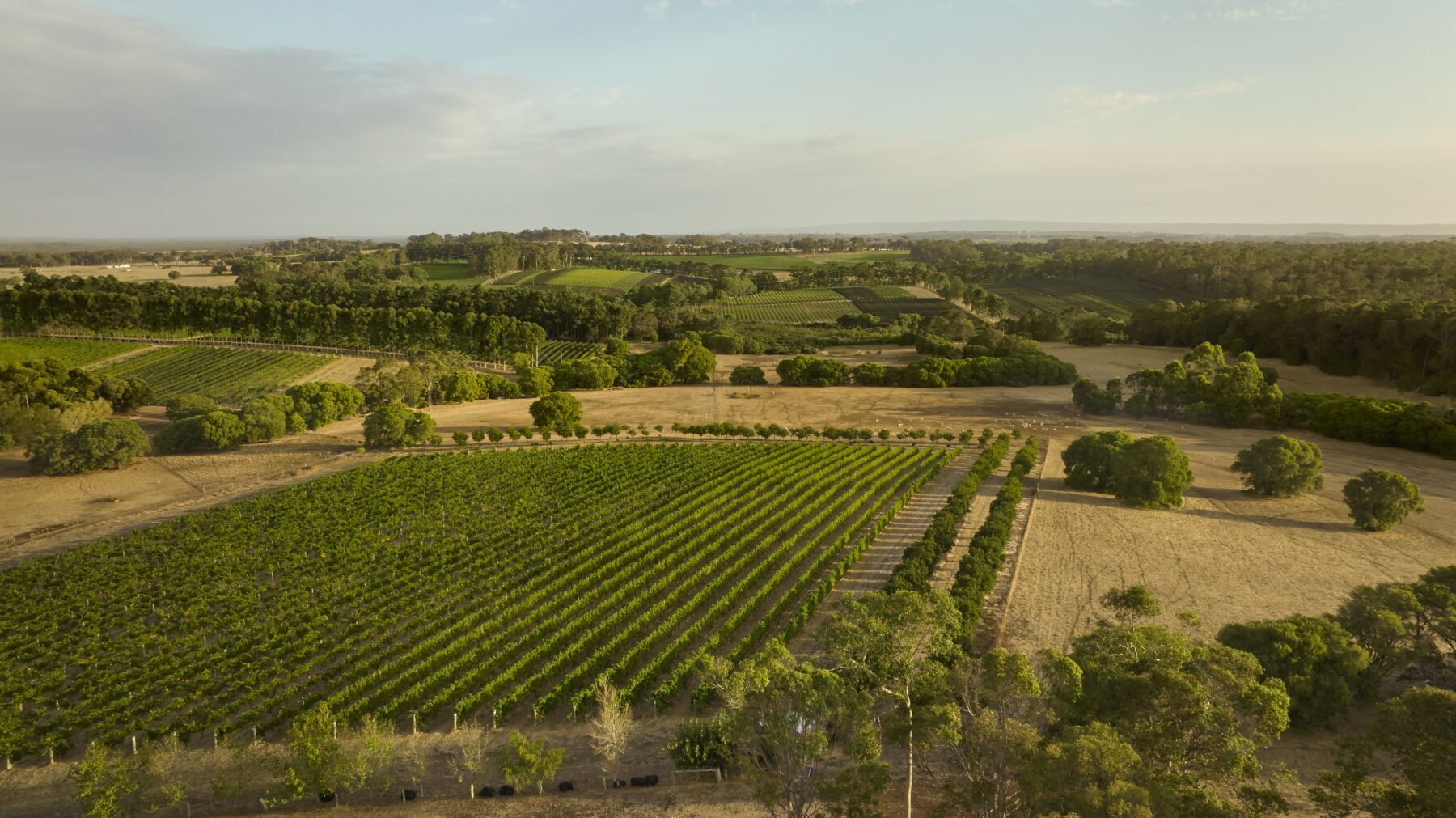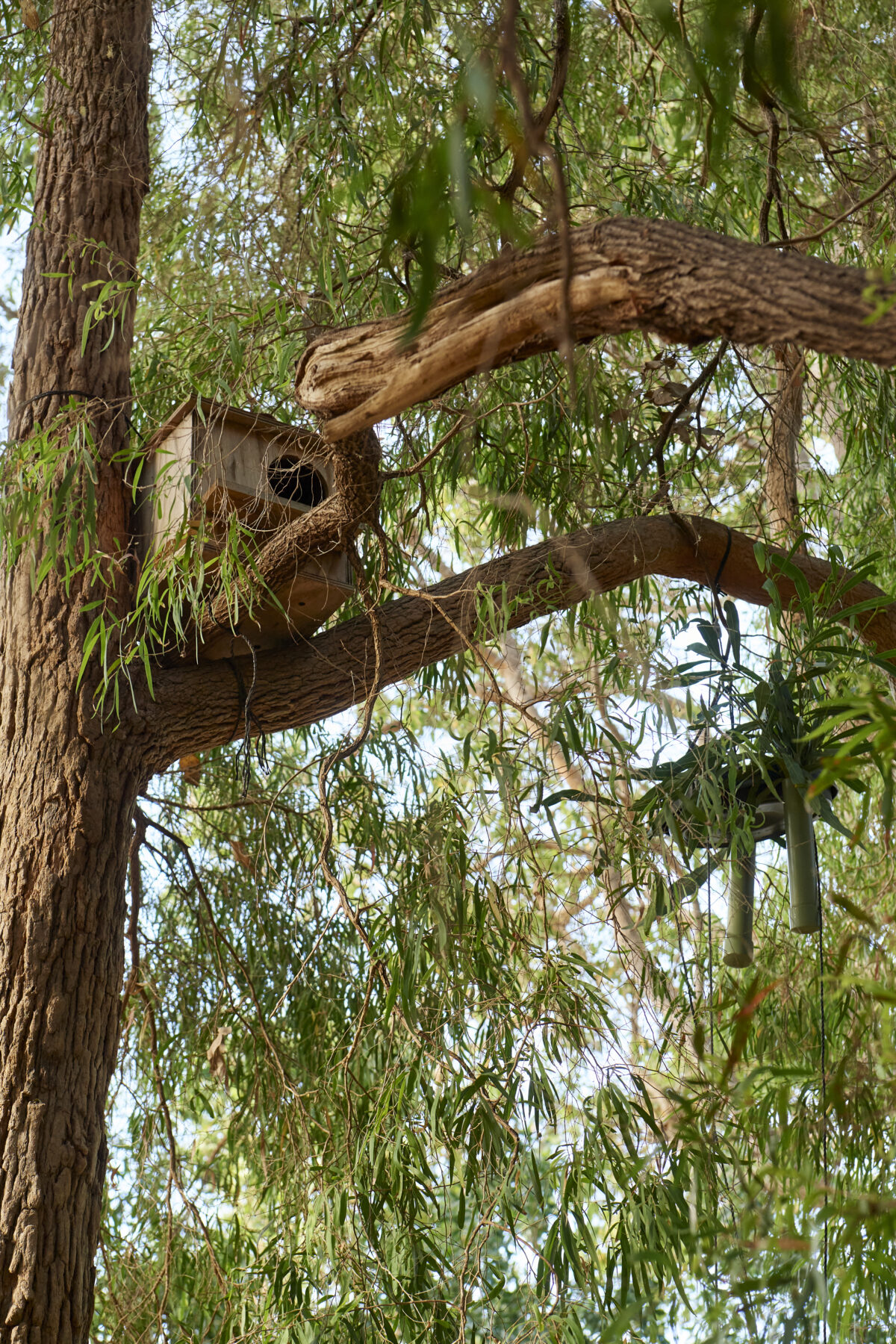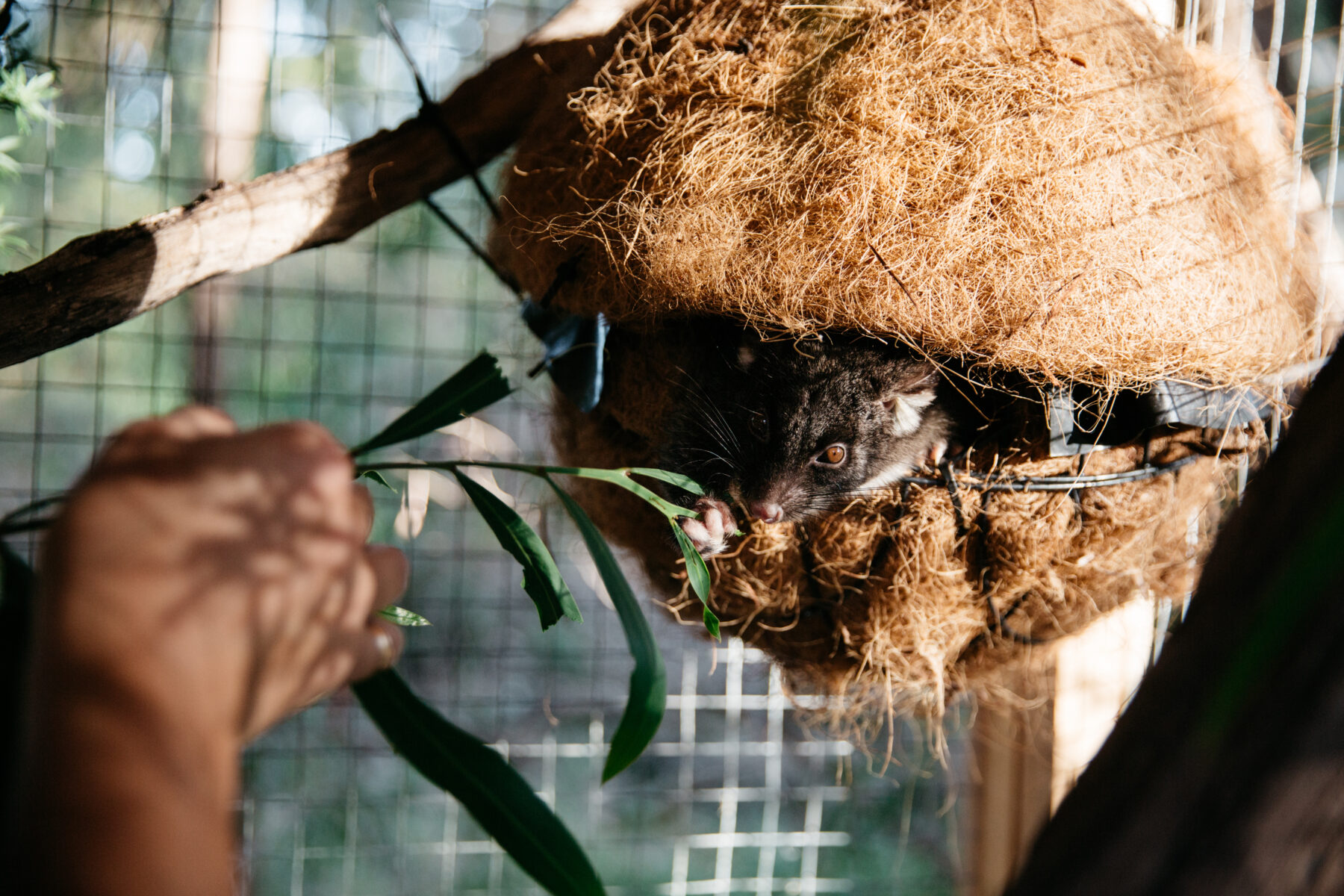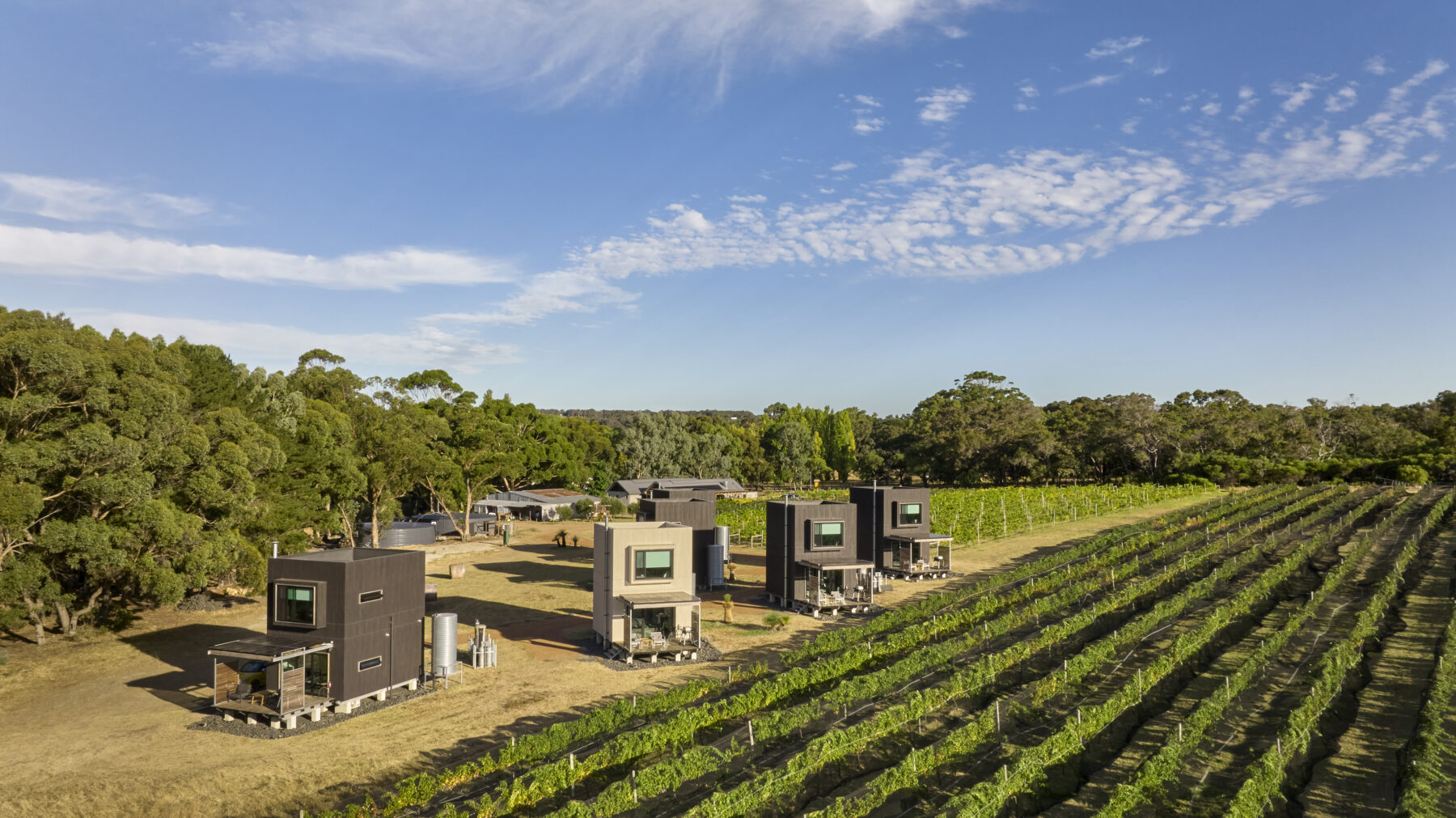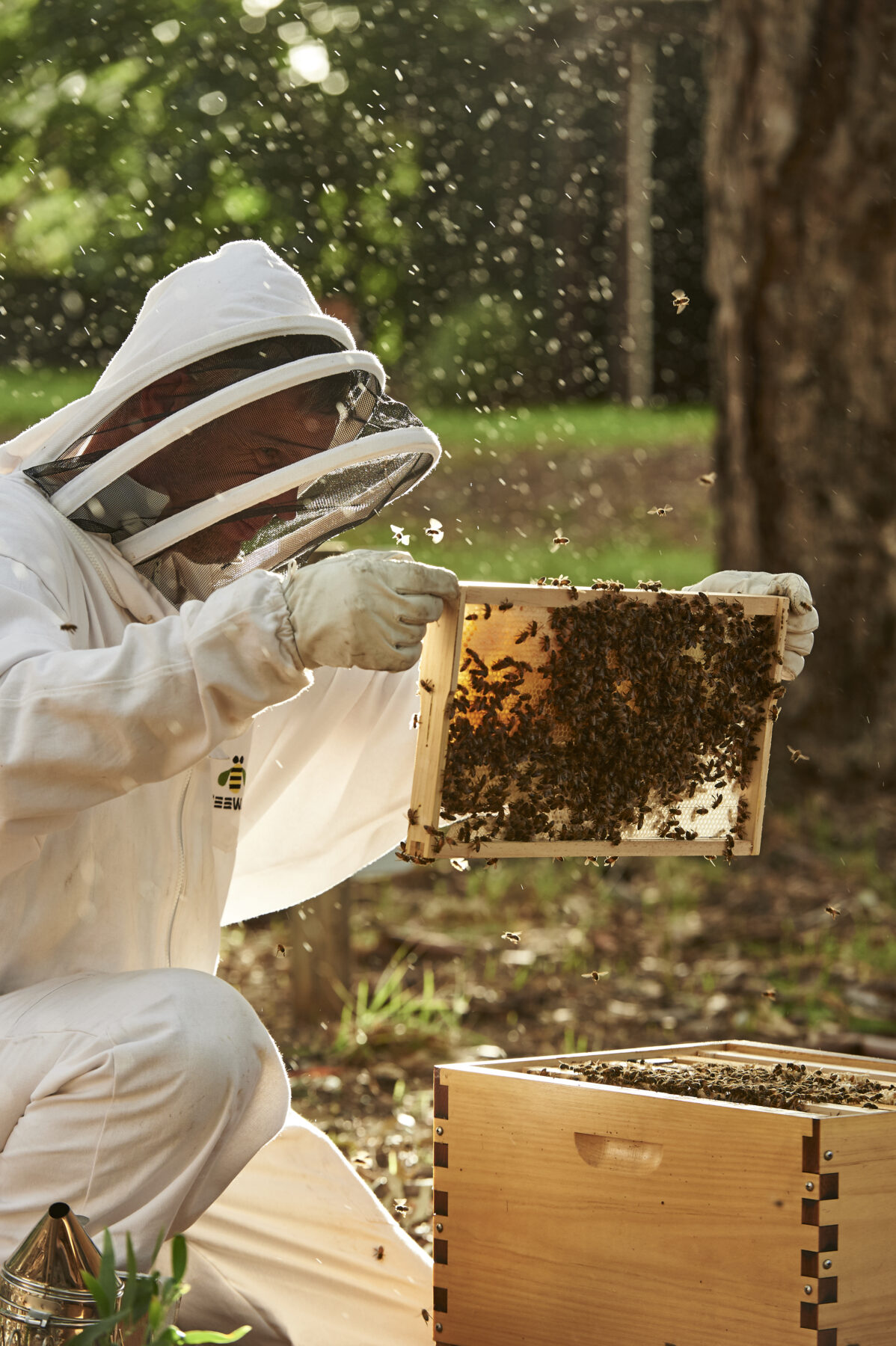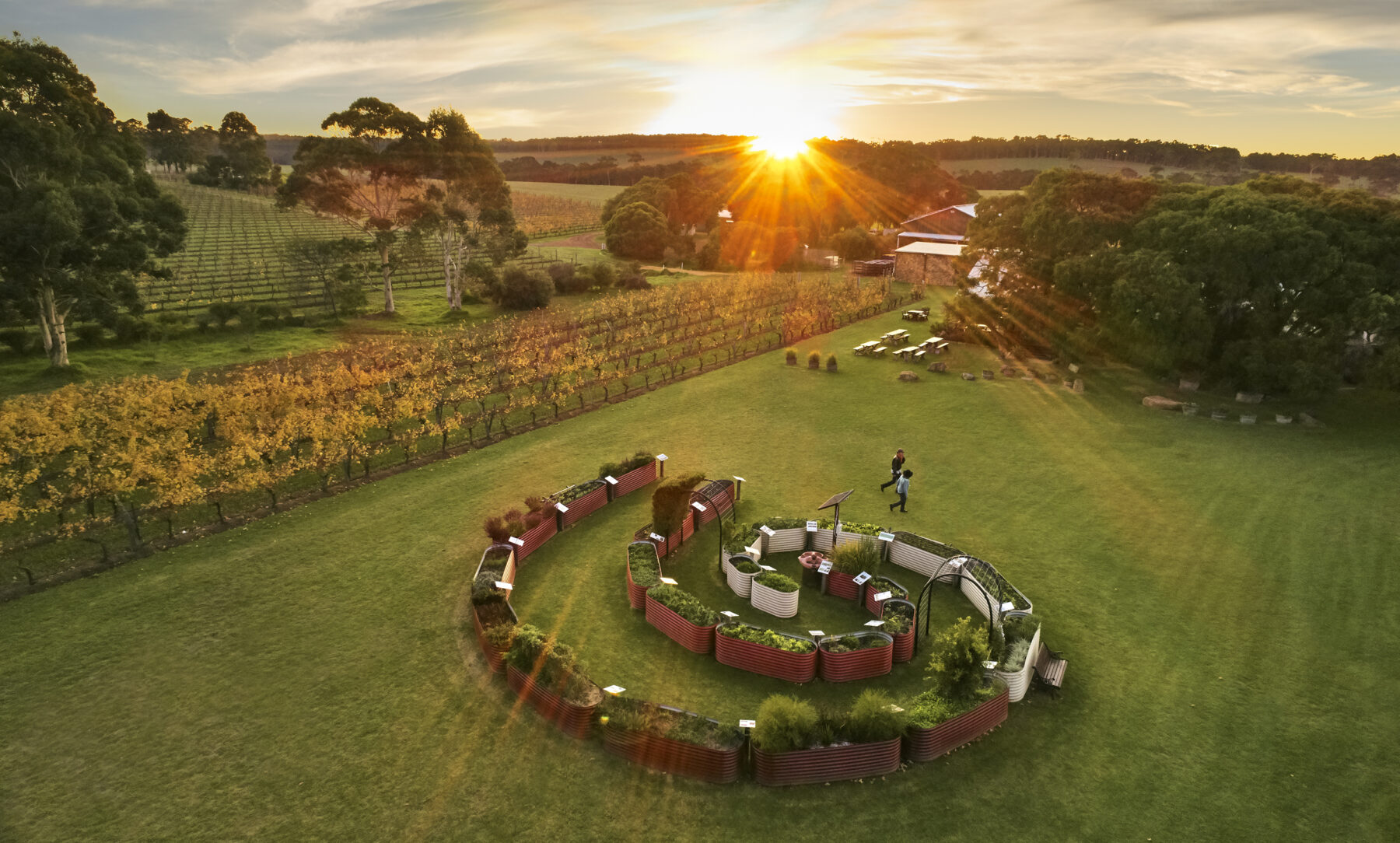Ben McDonald leans on a weathered wooden bar overlooking rows of grapevines that wouldn’t be here if not for his love story. He cracks a macadamia nut plucked from trees he planted 17 years ago and tells me he built this bar from planks upcycled from the old Bunbury jetty. Sheep graze nearby, tasked with vineyard weed-picking and flanked by a crack team of bug-busting chickens, while pigs destined for the farm restaurant snuffle inquisitively on the fence line.
Formerly a traditional wheat-and-livestock property, Glenarty Road was worked by three generations of McDonalds before its current custodian, Ben, and his winemaker wife, Sasha, changed gears. They met in the property’s driveway in 2014 when she came to buy what Ben had planned to be his last grape crop before he ripped out the vines and focused on sheep farming. Fate intervened and eight years later they sustainably produce wines, seasonal produce and grass-fed meats that visitors can sample at their restaurant and cellar door.
They follow a paddock-to-plate, nose-to-tail and ground-to-glass ethos, underpinned by regenerative farming techniques that rebuild the soil, eschew chemical use and embrace the wider ecosystem. They have a vegetable garden that supplies 80 per cent of what diners find on their plates and a cellar door housed inside a repurposed 1950s farm workshop where visitors swill and savour small-batch, minimal intervention wines. While you can do tastings there, you can also roam the Karridale property with a glass in hand, led between rustic, open-air vine-bars while plucking grapes and digging into house-made, zero-food-mile charcuterie.
This is not the image commonly held of Margaret River, Western Australia’s ultra-premium wine region now synonymous with wealth and sundrenched long lunches. But that’s just it: the posh perception is outdated.
An easy three-hour drive south of Perth, Margaret River, home to the Wadandi (saltwater) people, is quietly rewriting how a successful wine-and-tourism region looks and acts. Scratch away the genteel facade and you’ll find an earthy community deeply connected to its environment, with plenty of dirt under the fingernails.
Examples are widespread, from wineries building sanctuaries for endangered endemic possums to tourism operators volunteering to maintain walking tracks and accommodation providers planting bee-friendly bushland. Locals are committed to existing in tune with nature, regardless of whether anyone’s watching or not.
In June 2022, the Shire of Augusta Margaret River became a certified ECO Destination – one of less than a handful in Australia and the first in WA. ECO accreditation is a hard-won mantle bestowed by Ecotourism Australia. It recognises locations with outstanding natural environments, where efforts are being made to evolve sustainable and nature-based tourism.
“Sustainability seems to be at the heart of this community,” says Saul Cresswell, the shire’s sustainable economy officer and the person responsible for addressing the 100 core criteria required for ECO Destination certification. “All the surveys conducted by the shire show the community values the environment above all else,” he says. The shire has a target of net zero emissions by 2030, echoing the culture of environmental consciousness.
In applying for ECO accreditation, Saul noted community efforts, such as the Precious Plastic Margaret River social enterprise project that melts down plastic lids to convert into surfboard fins and other products. He also highlighted Re-Tyre Margaret River, a business that handmakes eco-vegan shoes shod with soles of old bicycle tubes and car tyres. The shire’s early adoption of the FOGO (food organics garden organics) bin system was also raised; the system has achieved landfill diversion of up to 60 per cent since its 2019 introduction. Saul says these efforts point to a destination that is performing well, something that undoubtedly impacts population.
Between the 2016 and 2021 census counts, the Australian Bureau of Statistics recorded a 17.8 per cent population upswing for the shire, where a total of roughly 17,000 people now reside – something Saul notes is a sustainability challenge in itself. “A lot of people have chosen to live here,” he says. “It’s got a nice combination of a high level of amenity, good quality culture, cafes that know how to make great coffee, and pubs with interesting live acts, plus all the environmental elements.”
Many attribute the area’s eco mindset to the beauty of its surrounds: wide tracts of towering native karri trees, curling surf that fizzes as 40,000 whales migrate annually and thousands of native wildflower species that bloom each spring. The wider region, known as WA’s South West, is one of only two global biodiversity hotspots in Australia, recognised for its high concentration of rare and endemic species.
One of those endemic species, the critically endangered western ringtail possum, keeps Wendy and Barry Stimpson up at night. The couple, who unplugged from hectic lawyer lives in Hong Kong and London to relocate to the calm of Margaret River, often find themselves checking the feed from night cameras installed on their property. There’s a thrill with each sighting of the furry locals – it’s estimated as few as 8000 mature creatures remain.
The pair bought their vineyard in 2011, chasing childhood dreams of nature conservation and species protection. Barry grew up in South Africa, inspired by a nearby wine estate that ran a cheetah conservation program, while Wendy would stage plays and donate the proceeds to the UK’s People’s Dispensary for Sick Animals. “In Hong Kong we’d dream of things that would sustain us, somewhere with unspoilt nature,” Wendy says.
“A third of the property was bush, and that was a big part of the attraction,” Barry adds. “Leaving conservation just to governments and officials is not the way forward. Private landowners have to take responsibility.”
With the ink barely dry on their new purchase, devastating bushfires tore through the region, displacing countless native species. When a community organisation looked to rehome rehabilitated western ringtails in the bush beside their shiraz block, the couple were “absolutely thrilled”. They’ve since installed soft-release enclosures to protect possums as they reintegrate into the wild, and planted native tree species such as WA golden wattle, to which the possums are particularly partial. They’ve also preserved a 50m-wide nature corridor linking dense, undisturbed tracts of bush where possums can travel without needing to descend from the canopy’s safety. They even named their property after the collective noun for possums: a passel.
At Passel Estate they now lead visitors along a nature and wine walk through possum habitat, with more than a third of the ticket price directed to conservation. Along the track, I notice balls the diameter of dinner plates made from twigs and leaves hanging high in slender peppermint trees. They’re dreys – possum nests – specially created by humans as extra shelter within the release zone. “They’re such a fragile animal with such a high mortality rate in the wild,” Barry explains. That one of the resident possums, called Amy, has given birth at least twice since her release in 2019, is heartening.
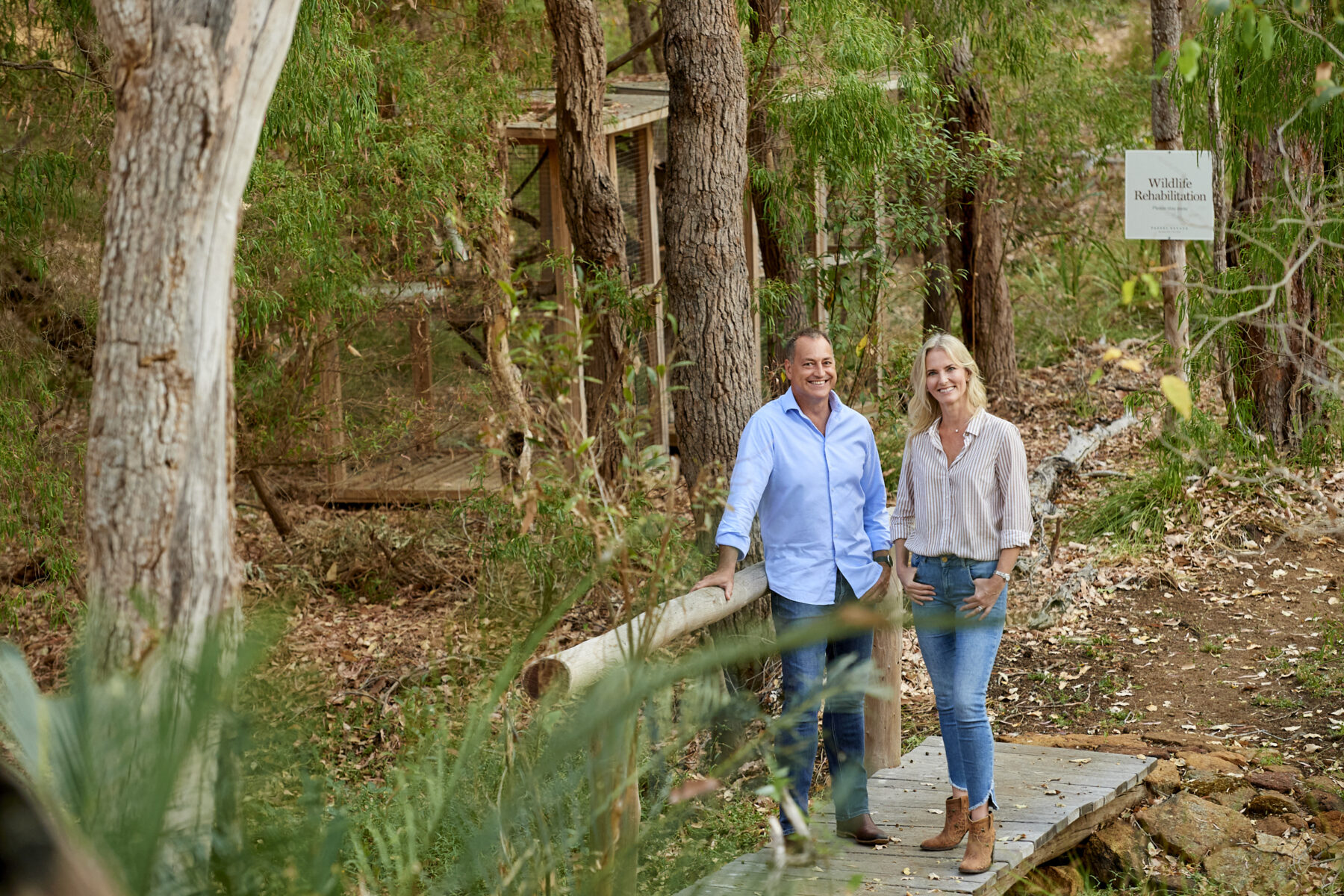
A creature of a different kind is the focus of Barnyard 1978, a vineyard, winery and honey farm with a restaurant and cellar door. The 7.5ha property features sustainable accommodation pods known as Barn Hives and is located a couple of kilometres from Smiths Beach, in the northern reaches of the Margaret River region. It doubles as a floral haven for native pollinators and European bees. Owners Egidijus (Egis) and Raminta Rusilas have deliberately planted species that ensure nectar-rich flowers bloom year-round. “We go for native species that will work with our climate,” Egis says. “We’ve put at least 400 plants in the ground and are continually planting new seedlings.” To sustain the honey-makers during winter, the pair chose flowering species such as lemon-scented gum and pin-cushion hakea, whose crimson, golf ball-like blooms are spiked with white pins. In spring, bottlebrush, thyme and sage take over. In summer, sunflowers, coastal daisies and nasturtiums become the bees’ resource. In autumn, Acacia species and coastal banksias meet the nectar needs. Their 19 beehives, six of which are onsite, annually produce about 3t of honey. The remaining hives are moved around the region seasonally.
The couple, originally from Lithuania, are inspired by every facet of bees and, in 2020, even built six boxy, double-storey eco pods that mimic human-made beehives. “A colony of bees starts in one box and they make the ground floor a living area,” Egis explains. “Then they grow up and we add a top box, called a super, as a honey-making spot – just like the top of our pods.”
Sleek, minimalist and modern, each villa is built on stilts and can easily be relocated, just as transportable beehives can. “Hives are put on a raised platform to discourage critters,” Egis says. An open deck provides unhindered views, something also valued by bees. “Bees like a clear flight path out their front door,” he says. “They like a deck for landing, too.” Clad in native jarrah and using no plastic in their construction, the villas use solar power, collect rainwater, leverage cross-ventilation airflow for cooling, and are equipped with wood pellet fires for heating. Fittingly, a jar of the property’s unprocessed raw honey is supplied to guests, along with eggs from the resident ducks and chooks who eat scraps from the restaurant kitchen. Solar-powered electric cars, known as Ebees, have recently been added for guests to rent.
The overall aim of the property is to show “that hospitality and environmental conservation can coexist”, Egis says.
There’s many a story in Margaret River of people cutting the cord from hectic urban lives, turning instead to a rural-setting salve. Tim Hall and Cree Monaghan fit the mould: he was in corporate training and development, while she worked as a zoo and wildlife veterinarian. In 2014 they hit the eject button and started a sustainable farm, from scratch. “The desire to live in the country was very strong,” Cree says. “Having kids, it satisfies a lot of desires, but we also wanted to have control over our own food and raise animals using high welfare standards.”
The couple bought a 40ha property near Cowaramup and learnt everything they could about regenerative farming from YouTube. They embarked on a paddock rotation program, shifting around livestock and seed crops to build soil biodiversity. “We follow organic and some biodynamic principles and use a lot of self-generated compost and green manure,” Cree says. Eight years on, they run One Table Farm – a cooking school overlooking a huge kitchen garden surrounded by more than 80 fruit and nut trees. Pecans, figs and coffee plants grow alongside leeks, eggplants and tomatoes; for the family, seasonal, plant-dominated eating has become a way of life.
Everything they’ve learnt on this grand, but gruelling, journey is now taught to cooking students as they knead sourdough in the school kitchen. Classes interweave teachings on regenerative farming and sustainable living practices, diving into carbon drawdown principles, food-waste reduction and solar-power use. A farm tour that involves hand-picking produce from the garden is as much a highlight as mixing dough in Tim’s mother’s large ceramic bowl – the same one he used when he first learnt how to bake bread.
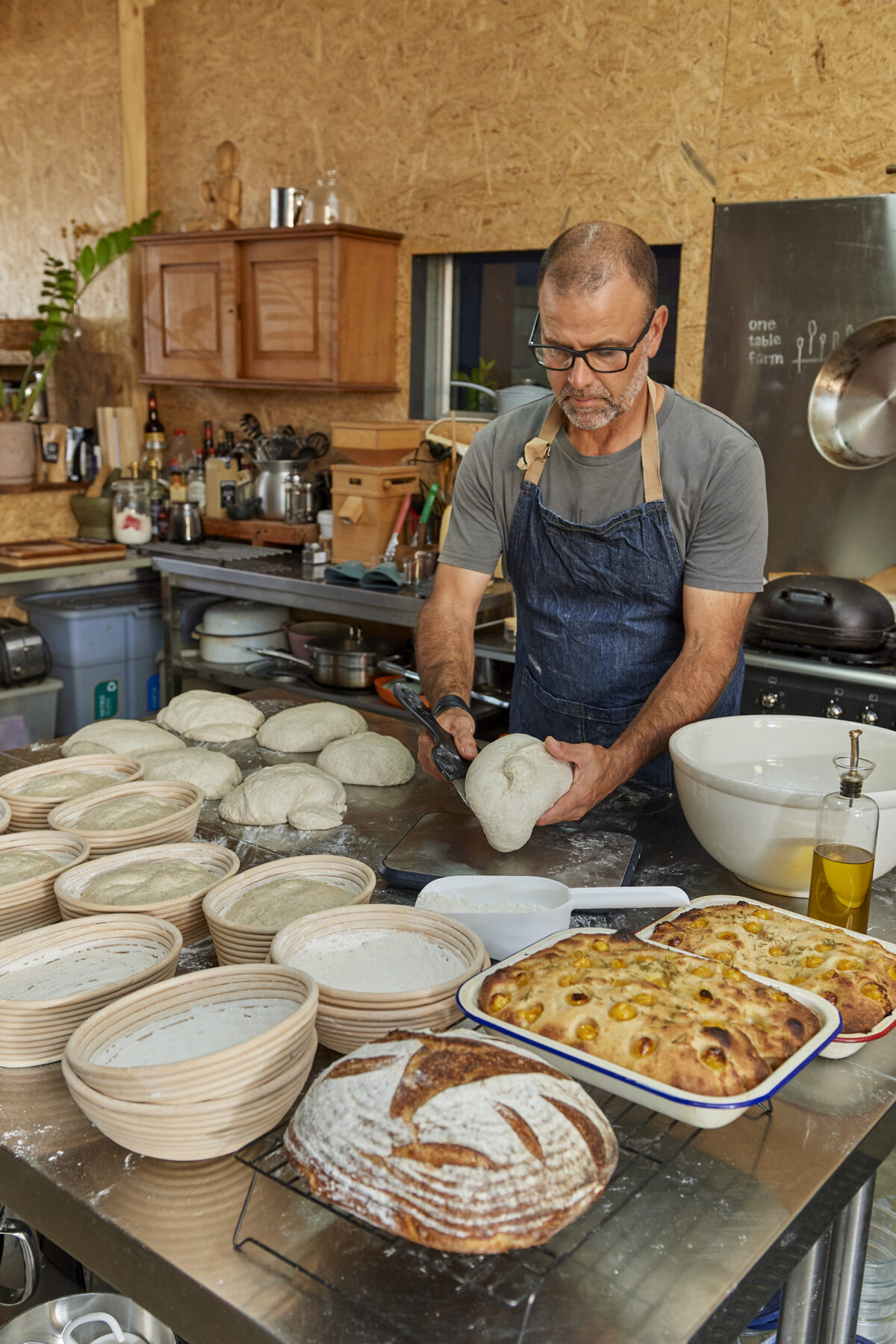
Plenty more people like Tim and Cree are likely to move to Margaret River in coming years, as a game-changing eco development grows. Witchcliffe Ecovillage already has two dozen residents. A forecast 350 solar-panelled dwellings – including 60 short-stay holiday cottages – are planned in the short-term. Not far south of the town of Margaret River, the development is being divided into clusters of 23 sustainable houses, each supported by a community garden, chooks, netted orchard, meeting place, and 232 kilowatt-hour Tesla power pack.
The homes will run on 100 per cent renewable energy and it’s expected each will eventually produce a carbon offset of 100t beyond the carbon used to build it. “We’re of the view that all regional areas in Australia should be self-sufficient,” says project co-founder Mike Hulme. He and partner Michelle Sheridan take me on a tour along paved streets in their hybrid car, pointing out green credentials. “We’ve got our own solar-powered wastewater treatment plant; it recycles the water onto a wood lot and avocado orchard,” Mike says. “We also have three dams where stormwater drains; the dams water 16 organically certified agriculture zones growing vegetables, berries, fruit trees and a vineyard. We’re planning a food-hub site, like an indoor market, and we want to have zero-packaging options for grocery shopping.”
Mike identified the site in 1994, back when he ran a permaculture centre and taught courses on sustainable human settlement and design. He shifted into land development, hoping to one day create the eco village he carried in his mind. A 23-year partnership with the late businessman, billionaire and philanthropist Stan Peron allowed it to become reality. Peron passed away before a sod was turned – planning approvals took a frustrating 10 years – but this property will become Mike’s legacy. “If you look at the blue zones around world [where people live the longest and are healthiest], they’re defined by having a strong community, calorie restriction and good local organic food consumed and grown as a community,” says Mike. “My dream is that not only will this become a model of sustainable development, but also a future blue zone.”
Already there are geologists, nurses, writers, architects, winemakers and a Sydney-based filmmaker taking part in Witchcliffe’s collaborative – rather than communal – living space. Mike and Michelle are building their own home within the village, whose largest buyer group is 30–40-year-olds with young families. “We’re thrilled with the demographic,” Mike says.
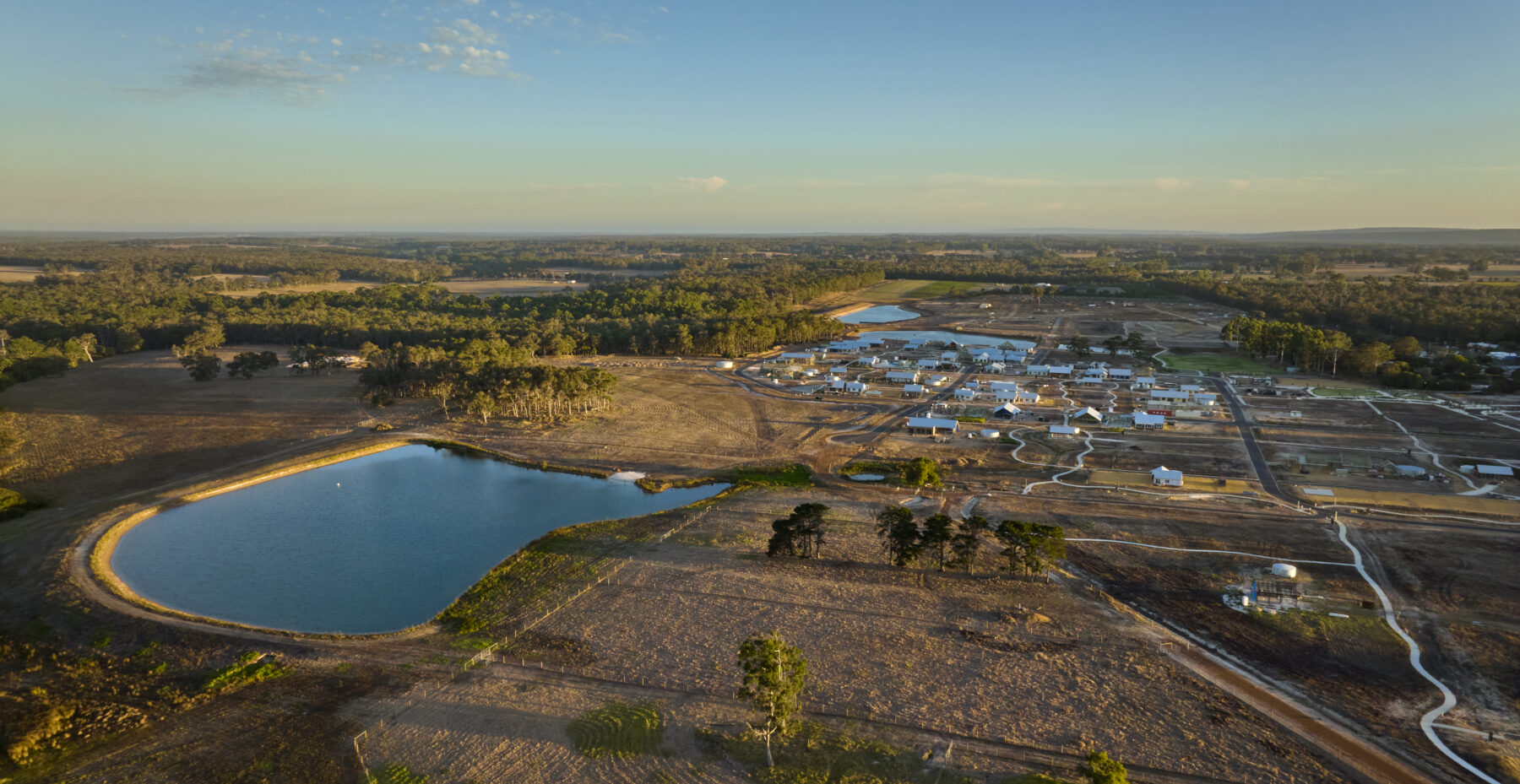
Rachel and Andy Clough and their son, Jesse, were the first to move in, in June 2021. Their solar-passive home has no air conditioning and, other than some pink salt lamps and a hemp couch, looks decidedly mainstream. “People get the impression it’s maybe some sort of commune, and there are definitely more alternative and quirky people, but there are a lot of people who are just more interested in the community,” says Rachel, a former project officer for Western Power.
Andy, who uses the village’s NBN connectivity to manage international university payments from his home office, says it’s the best thing they’ve done. “Now we talk about eating roos, catching snakes and building a house from handmade bricks. Before, I was in this box where you go to uni, sit exams, get a job. The childhood we can offer to Jesse, it blows my mind.”
Rachel suggests a healthy dose of perspective is at the heart of the region’s green-leaning vibes. “Most people who live in Margaret River are really focused on a healthy balance in their life,” she says. “If they can, they don’t work full-time, or they do flexi hours. It’s about wanting the good life, and that’s going to the beach and having fish and chips with mates on a Friday. It’s a philosophy of ‘let’s make the most of every day’.”
Gene Hardy is a Margaret River original. He grew up chasing tadpoles in the region’s eponymous river before becoming a competitive surfer, travelling the world as a surf journalist, then shifting into working for conservation agencies. Nowadays, he and his team guide and support walkers along the region’s iconic walking track between Cape Naturaliste and Cape Leeuwin. Cape to Cape Explorer Tours, Gene’s company, follows the principles of the Leave No Trace organisation and has adopted a 3km stretch of the track to maintain. Staff – many of them surfers –
also volunteer for community greening days, including a recent planting event to increase habitat for the western ringtail possum. The Advanced Ecotourism- accredited business sources food locally and uses recycled packaging, but perhaps its most significant achievement is revealing the many layers of the region’s natural assets so visitors care enough to protect it. “We start with the geology, then we explain the marine biology. We cover flora and fauna and finish with anthropology and the connectedness of everything,” Gene explains. “We talk to people about what they can do at home, from using local flora in their gardens to preserving water and helping out with community groups.”
When asked why Margaret River’s reputation is one of flashy wineries rather than Earth-nurturing sustainability, Gene is pragmatic. “That’s just marketing: who has the biggest budget and what are they selling? There’s a lot of wineries,” he says, although he’s quick to point out the wine sector knows its place in the overall ecosystem. “Unlike some areas with broadscale agriculture and monocultures of vines, here it’s very focused on high quality and low quantity. A lot of the vineyards are surrounded by native bush and forest, and they use the local environment to shelter the vines and be in harmony with nature.”
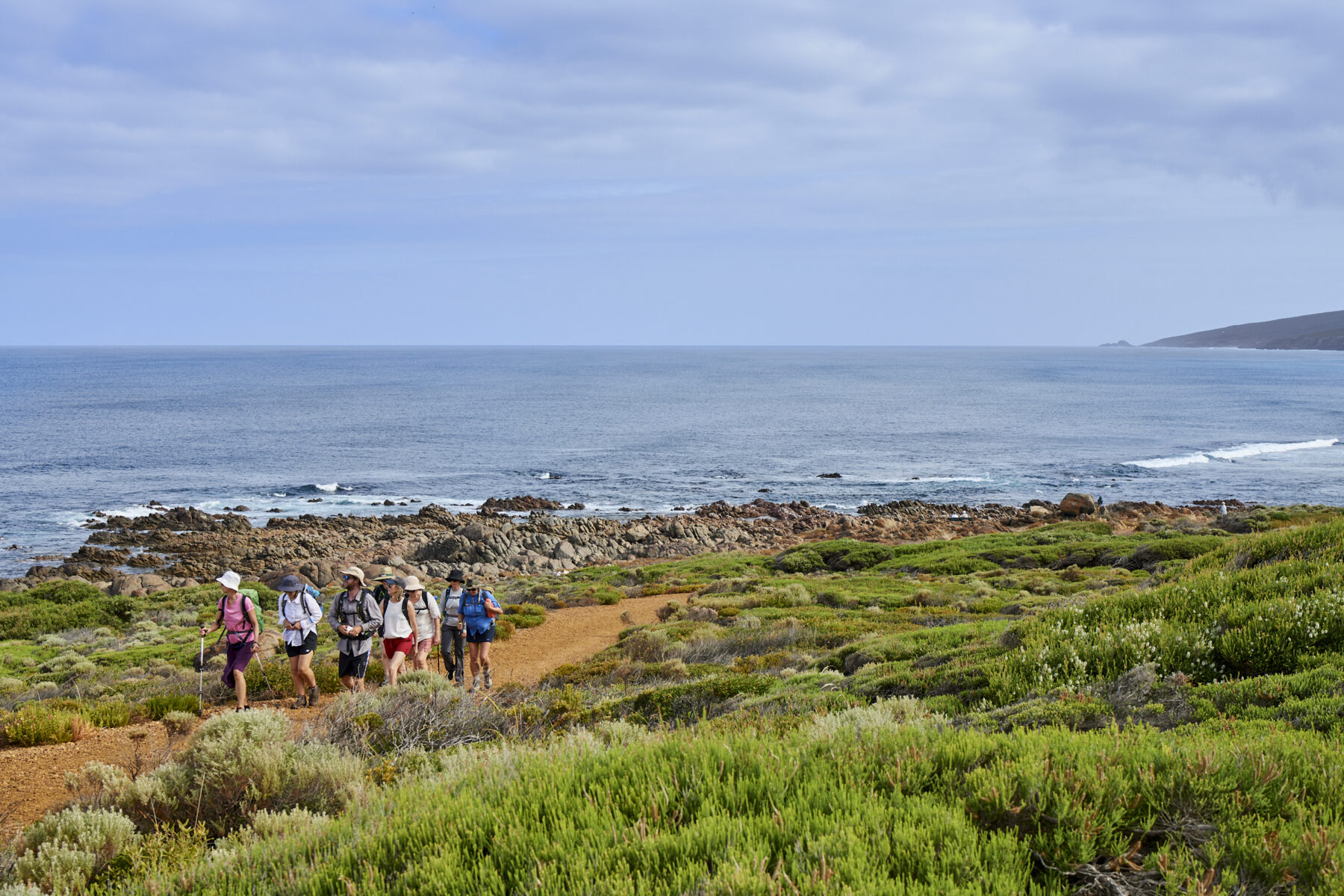
Cullen Wines is arguably the region’s standout sustainable wine estate. The vineyard, winery and restaurant have been embracing minimal intervention for half a century. Founded in 1971, the switch to organic viticulture was made as far back as 1998, with biodynamics following in 2004. Moonlight harvesting, biodynamic compost preparations and burying quartz crystal–filled cow horns in the earth are all regular practices driven, says winemaker Vanya Cullen, by science, not sorcery. The finished product, contained in carbon-reduced bottles, makes a compelling case. Distinctive for its clarity and purity, it is among the most coveted wines in Margaret River.
Glenarty Road’s Sasha McDonald was working as a cellar hand at Cullen Wines before meeting her husband, Ben. It’s no coincidence the philosophies she was exposed to there have influenced their sustainability-focused operations. “The balance in wine is created in the soil,” she says. “If we put more energy into that, there’s less need for chemical additions, less reliance upon oak and it allows the fruit purity to shine through.”
Cullen’s biodynamic spiral garden (left) showcases principles of the farming techniques used in its vineyards and kitchen garden – it’s part of the Margaret River Organic Garden Trail. (Right) Harvested red wine grapes are stacked, ready for crushing, during Cullen Wines’ annual vintage.
As other wineries join the sustainable movement – Voyager Estate and Vasse Felix certified their vines as organic in 2020 and 2021, respectively – Sasha expects it to become the default position for the local wine sector. “The groundswell is huge,” she says. “It’s not yet the norm, but it’s a conversation that’s been more common in the past five years. Margaret River’s becoming a region to watch for that.”
